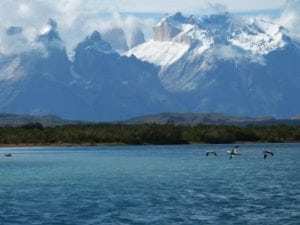Patagonia is home to our Journey to Ushuaia tour. It’s a long way down—the only land further south in the world is Antarctic. Few people inhabit the area and fewer travel there. Here’s a brief introduction to this land of spectacular beauty.

Facts about Patagonia
- Patagonia covers the southernmost tip of South America. It’s shared by Chile and Argentina, divided by the Andes. It’s one of the least populated areas of the world—one to two persons per square kilometer, comparable to Namibia at 2.6, and Mongolia at 1.9.
- Argentinian Patagonia faces the Atlantic coast and features a series of 13 terraces, each rising about 100 metres at a time. It’s home to steppes, grasslands, pampas (fertile plains) and deserts. Lakes and ponds of fresh and brackish water lie in the hollows of the plains.
- Chilean Patagonia has glacial fjords and temperate rainforests along its Pacific exposure. Animal life is more abundant and vegetation more luxuriant than on the Argentinian side.
- Volcanic eruptions cover a large part of the central region with basaltic lava caps. More recent glacial deposits cover the lava on the western side.
- The climate is cool and dry. Ocean currents make the east coast warmer than the west, but winters are colder on the inland plateaus east of the slopes. The best time to visit is between October and March.
- Common mammals are the guanaco, cougar, Patagonian fox, Patagonian hog-nosed skunk, and the Magellanic tuco-tuoc (a subterranean rodent)
- Argentina’s Perito Moreno Glacier contains the world’s third largest reserve of fresh water. It’s one of two glaciers in South America that are growing.
- The 260,000 square mile Patagonian Desert is the largest desert in the Americas and the eighth largest in the world by area. The Kalahari is 360,000, the Gobi is 500,000.
- People have habited Patagonia continuously since 10,000 BC. Hearths, stone scrapers, and animal remains dating to 9400 to 9200 BC have been found in Chile. The Cueva de las Manos, a cave at the foot of a cliff in Santa Cruz, Argentina, is covered in wall paintings. Most significant, are the negative images of hundreds of hands, believed to date from around 8000 BC.
- A wild horse herd, considered one of the largest and last in the world, has resided in the mountains around Cape Horn for more than a century without human contact.
- A group of nearly 200 Welsh people sailed to Argentina in the mid-1800’s to establish utopia. After a rough start, their settlement took root. Over several decades, they transformed the scrub-filled semi-desert into a fertile and productive area. They evolved a distinct dialect of Welsh, known as Patagonian Welsh, understood by speakers from Wales and Patagonia.
- Ushuaia (Read 13 Facts About Ushuaia) is the world’s southernmost city and a busy port and adventure hub.
- The calafate berry, also known as the Magellan barberry, grows on a bush that becomes covered in yellow berries in summer. Legend says that anyone who eats the blue-black berries fresh or in jam will be sure to return to Patagonia.
Resources:
- World Wildlife Org.
- Just Fun Facts
- Wikipedia
- Historic UK – History of Wales
- The Patagonian Foundation
- World Atlas
Photo on VisualHunt

